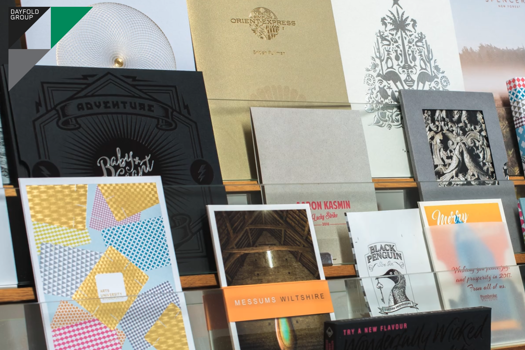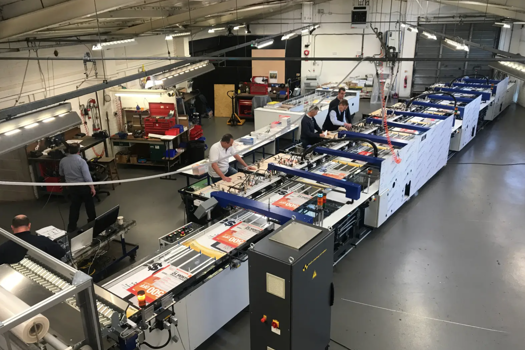You show me a business that has not been enhanced by print," challenges Sidney Bobb, chairman of the British Association for Print and Communication (BAPC). For him, the power of print has brought benefits to companies of every size and every occupation.
But print is under pressure like never before. It faces challenges, not only from the turbulent economy, but also from competing technology. Pretty much every sector is feeling the pinch as companies look to find new ways of communicating with their customers: printed direct mail goes toe-to-toe with email and SMS; devices like Sony's e-reader and Amazon's Kindle are aiming to eat into the printed book market; and newspapers are now suffering from dwindling sales thanks to a growing number of readers migrating to the internet.
It might seem that print is a dying sector, but reports of its demise are wide of the mark. While volumes are declining in many markets, the demand for printed materials is still there. Brochures, point-of-sale and highly personalised direct mail are the kind of applications that can still have an impact with consumers.
It's also not simply a case of laying ink on paper. Print is more powerful than that: clever designs and dazzling finishing can tantalise the senses of consumers, as well as gaining a useful return on investment.
We've picked a couple of examples of print campaigns that demonstrate that, if a print firm has a hand at the design stage, the results can be incredibly powerful (see box outs). Each campaign backs up Bobb's assertion that pretty much every company, throughout the length and breadth of the country, has benefited from a well thought through and executed piece of print.
Print advantage
One of the examples comes from Geoff Neal Litho. Its founder, Geoff Neal, believes that a well conceived piece of marketing can go far further than an electronic correspondence. "There is a feeling among some marketers that electronic forms of communication are better," he says. "But we all get pelted everyday with unsolicited e-mails and many people just hit ‘delete'. With a direct mail piece, you can just throw the correspondence away, but, if the mailer does its job, then it can make the recipient open the envelope."
You'd perhaps expect a printer to say that, so it's worth getting a different perspective. James Mountain is senior art director at integrated marketing agency GyroHSR. "What we are finding is that by combining digital communications ?
with print we can get some terrific results. They complement each other - it's a matter of choosing the relevant way. It also depends where it appears. Posters can have a very strong impact, but then so can online - it is also very powerful. From our point of view, it's great to use a mix."
Direct marketing is one area in particular that's benefiting from a more joined-up, multi-channelled approach. A mailshot can give consumers a web address for them to access personalised offers or an SMS text can trigger a personalised piece of printed direct mail. It's these kind of campaigns that have been shown to boost the return on investment for brands - traditional direct mail response rates of 2% have gone up to around the 10% thanks to a creative use of variable data.
Tangible benefits
But alongside a clever use of data, there needs to be an element that grabs the consumers' attention and print can do this. "I love looking at print," adds Mountain, who was also a judge for the 2009 PrintWeek Awards. "There is something special and tangible about handling a beautiful bit of printed work."
And with a bit of forethought, it can be cost effective. Last month, Thomson Holidays rolled out a mailing pack featuring a 12-page brochure with a voucher and a total of 50,000 were printed. The project was designed by WDMP and printed by Romford-based Purple Results.
The clever bit came in the design. Measuring 240x165mm, the pack was able to get around the additional postal costs incurred by Royal Mail's Pricing in Proportion. It goes to show that with some smart thinking, print can still be an affordable, as well as creative, medium.
It's a challenging time for the print industry, but there are plenty of creatives and designers prepared to use the medium creatively, not just in direct mail, but also through other applications. And with several brands keen to link it to other media channels, there remains a future for print, despite the doom and gloom stories generated over the past year. As the BAPC's Bobb concludes, every business in the land has had to use print and, in some way, has benefited from it. Print, when used properly, will continue to be a powerful marketing communications tool.
LK BENNET
There were times when designing the Christmas in-store campaign for luxury women’s fashion chain LK Bennett was a nightmare, according to Andrew Brown, creative director at Harlequin Display. He admits that he didn’t think that creating a giant shoebox, measuring over 2m tall, could ever work. But it did and it provided UK stores with an eye-catching point-of-sale display that has even gone into a couple of stores abroad.
At first, I didn’t think we could do it. The project took a total of 250 man hours to complete, he says. It was highly detailed.
The window display forms the centrepiece of LK Bennett’s Christmas campaign and is designed to entice dedicated female followers of fashion through its doors. The brief was to make the display high profile and in keeping with the premium nature of the brand. An oversized shoebox measuring 2.2x1.2m was the solution.
It was printed directly onto silver foil and was all hand assembled and delivered straight to the store, adds Brown. There were a total of 70 full-sized shoe boxes and for the smaller stores we printed the main graphic on the inside of the lid. For both sizes, the idea was to show off their own photography. This was exceptionally good.
And show it off they did, with a striking image printed onto the inside of the lid. It was digitally printed at sister company, Harlequin Graf, on a Vutek PressVu wide-format machine.
Harlequin Display is no stranger to working with the big brands, with sportswear company Puma one of its clients. And even though the LK Bennett campaign could be a nightmare to put together at times, the result was striking and can be viewed in stores this month. We have set a benchmark with this campaign, says Brown.
BOOTS: CAREFREE SAMPLING PACK
Geoff Neal Litho is a direct mail print firm that has won its fair share of awards over the years. It scooped this year’s direct mail printer gong at the PrintWeek Awards for a raft of high-quality mailings for top-notch clients including VW, Olay and Boots. The last of that collection was a fun, effective and feminine mail piece highlighting the retailer’s Carefree brand.
It had to be fun and catchy, recalls Geoff Neal, founder of the company. The aim was to get something in front of the consumer and make them open it.
The striking pink envelope contained a raft of products for recipients to sample, plus a leaflet in the shape of a pair of female briefs. It fitted in nicely with the fun and catchy part of the requirements. But the drive’s success came through teamwork. Neal stresses that the company didn’t design the pack, but he adds that there was a solid relationship with the client that enabled them to find the best possible solution.
It’s very frustrating to sometimes hear about stories where the printer hasn’t been told anything about the budget
and the designs – it’s very short-sighted, he says. It’s important to involve the printer at an early stage.
We can sometimes be more flexible on the design front – we take the creative brief and put it into a workable item. We use our expertise to turn it into a productive item.
The Boots campaign’s print run ran to more than 200,000 and took the traditional litho route. According to Neal, litho still has a lot to offer in terms of quality and run lengths.
But that doesn’t mean that the campaigns it runs are untargeted mailshots – the days of carpet bombing are over.
Direct mail has a considerable future and is getting ever more targeted, he adds. Our customers have sourced the right customers to communicate to – it’s not a case of mailing an envelope and praying it gets to the right market.










